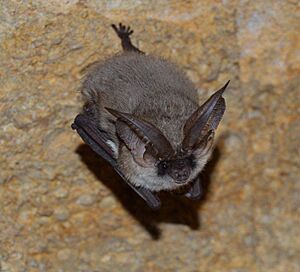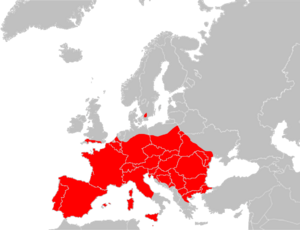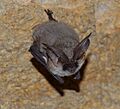Grey long-eared bat facts for kids
Quick facts for kids Grey long-eared Bat |
|
|---|---|
 |
|
| Conservation status | |
| Scientific classification | |
 |
|
| Range of P. austriacus |
The grey long-eared bat (Plecotus austriacus) is a medium-sized bat found across Europe. It's known for its very long ears, which have a special fold. This bat often hunts for moths and other insects, sometimes even during the day, usually above woodland areas.
It looks a lot like the more common brown long-eared bat. Scientists only realized they were different species in the 1960s! You can tell them apart because the grey long-eared bat has a paler belly.
What They Eat and How They Hunt
Grey long-eared bats mainly hunt for food in open areas like lowland meadows and marshes. They are very good at catching insects.
These bats use a special skill called echolocation to find their prey. This means they send out high-pitched sounds. When these sounds bounce off objects, like a flying moth, the bats hear the echoes. This helps them create a sound map of their surroundings and find their next meal, even in the dark! The sounds they use for echolocation are usually between 18 and 45 kilohertz (kHz).
Where They Live
You can find the grey long-eared bat across most of Europe. However, they are not found in the Scandinavian Peninsula (like Norway and Sweden).
Protecting These Bats
The IUCN lists the grey long-eared bat as "Near Threatened." This means they are not in immediate danger, but their numbers could become a problem in the future.
Even though they are found in many places, a study in 2013 showed that this species was very close to disappearing in the United Kingdom. One big reason for this decline is that they are losing the places where they hunt for food.
A special project called Back from the Brink is working to help these bats in the UK. They are trying to create more good hunting grounds around the places where bats sleep, called roost sites.
Climate change is another threat, especially for bats living in Southern Europe. Scientists worry that bats, especially those that live a long time and have few babies, might not be able to adapt quickly enough to a changing climate. In the future, people might even need to move bats to new, safer areas as the climate changes.
Images for kids




